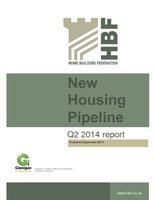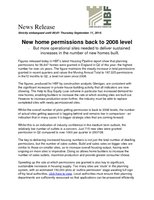New home permissions back to 2008 level
But more operational sites needed to deliver sustained increases in the number of new homes built.
Figures released today in HBF’s latest Housing Pipeline report show that planning permissions for 56,647 homes were granted in England in Q2 of this year- the highest number for over six years. The figure maintains the steady increase in total permissions granted in recent quarters and raises the Moving Annual Total to 197,325 permissions in the12 months to Q2, a level not seen since 2008.
The figures, produced for HBF by construction analysts Glenigan, are consistent with the significant increases in private house building activity that all indicators are now showing. The Help to Buy Equity Loan scheme in particular has increased demand for new homes, enabling builders to increase the rate at which existing sites are built out. However to increase production even further, the industry must be able to replace completed sites with newly permissioned sites.
Whilst the overall number of plots getting permission is back to 2008 levels, the number of actual sites getting approval is lagging behind and remains low in comparison - an indication that in many cases it is bigger strategic sites that are coming forward.
Whilst this is an indication of industry confidence in the medium term outlook, the relatively low number of outlets is a concern. Just 715 new sites were granted permission in Q2 compared to over 1000 per quarter in 2007/08.
The key to delivering increased housing numbers is not just the total number of dwelling permissions, but the number of sales outlets. Build and sales rates on bigger sites are similar to those on smaller sites, so to increase overall housing output, having work ongoing on more sites is imperative. Doing so allows home builders to increase the number of sales outlets, maximise production and provide greater consumer choice.
Speeding up the rate at which permissions are granted is also key to significant, sustainable increases in housing supply. Too many sites are ‘stuck’ in the planning system, with an estimated 150,000 plots at ‘outline permission’ stage awaiting full sign off by local authorities, click here to view. Local authorities must ensure their planning departments are sufficiently resourced so that applications can be processed efficiently and speedily and work can get started on new sites as soon as possible.
Speaking today, Stewart Baseley, Executive Chairman of the HBF, said;
"The increase in the overall number of new homes getting planning approval is very positive. Everyone is agreed that we need to dramatically increase house building to address our housing crisis and so getting more planning permissions is imperative."
"The comparatively low number of actual sites getting permissions is concerning. We need to see work underway on more sites if the overall number of new homes being built is to continue to increase."
"In addition, too many sites with outline planning permission are now stuck in the planning system awaiting final permission to start on site. We estimate there could be as many as 150,000 plots across the country in such a position."
The HBF report is a strong forward indicator of future levels of home building. A large proportion of these homes will be built over the next two to three years. Builders are looking to start work on new sites as they build out their existing sites more quickly as demand for new homes increases, driven in particular by the Help to Buy Equity Loan scheme.
Allan Wilén, Glenigan’s Economics Director said; "The marked rise in the number of new homes securing approval has been driven by strong growth in private sector projects. Strikingly approval figures have been boosted by a number of large scale redevelopment projects, such as the Earls Court scheme in London, which should provide a flow of new housing supply over the coming years. In contrast the drop in social housing projects is disappointing given the pressing need for more affordable housing."


